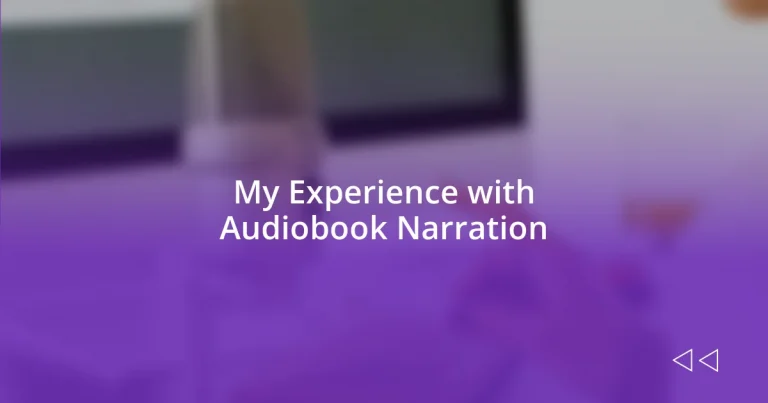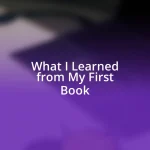Key takeaways:
- Audiobook narration is an art that combines voice interpretation and emotional engagement, transforming text into immersive experiences.
- Essential equipment for high-quality narration includes a good condenser microphone, closed-back headphones, and audio editing software to enhance recordings.
- Successful narration techniques involve voice modulation, tone variation, and a well-equipped home studio to create a comfortable and effective recording environment.
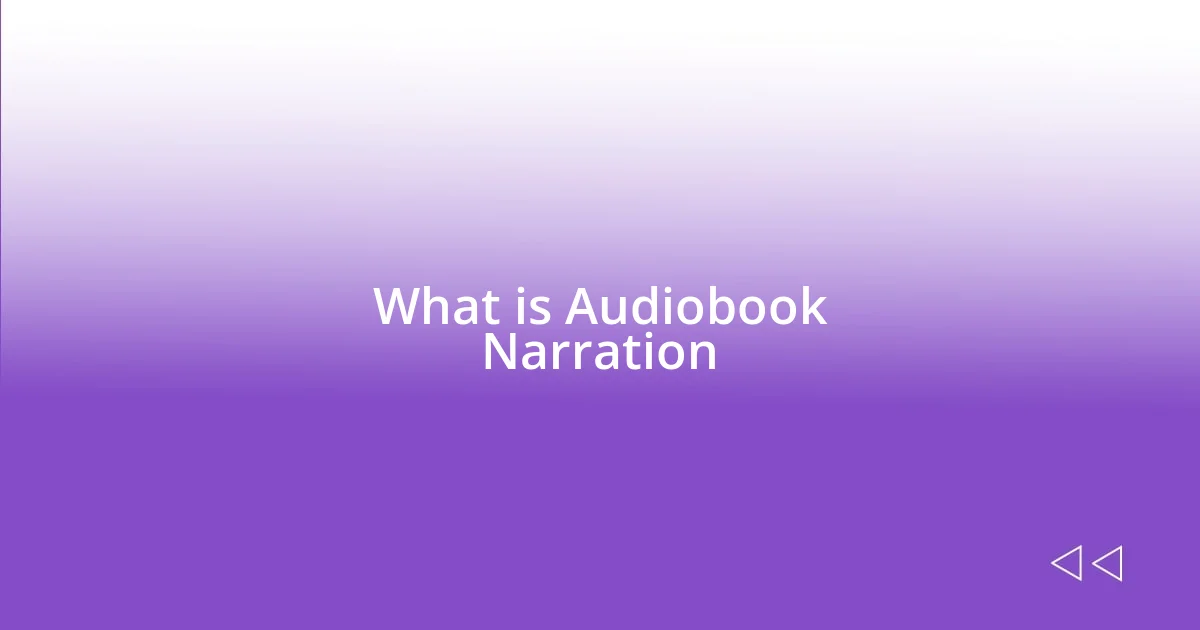
What is Audiobook Narration
Audiobook narration is the art of bringing written stories to life through voice. I remember my first encounter with a captivating audiobook—it was like discovering a new world where the characters felt as real as friends. Isn’t it incredible how a skilled narrator can transform a simple text into a vivid experience?
When narrators step into the role, they embody characters, employing various tones and emotions. I can’t help but admire how some narrators can evoke laughter or even tears just through their delivery. Don’t you find it fascinating how a single voice can convey the nuances of a narrative, making you feel every twist and turn as if you’re part of the story?
The process of audiobook narration involves not just reading, but interpreting the author’s intent. Each pause, emphasis, and inflection can dramatically change the listener’s understanding of the plot and characters. I’ve often reflected on how challenging yet rewarding it must be to capture the essence of a book while staying true to the original message. What do you think makes a narrator unforgettable? For me, it’s the connection they create with the audience, drawing us into a shared adventure.
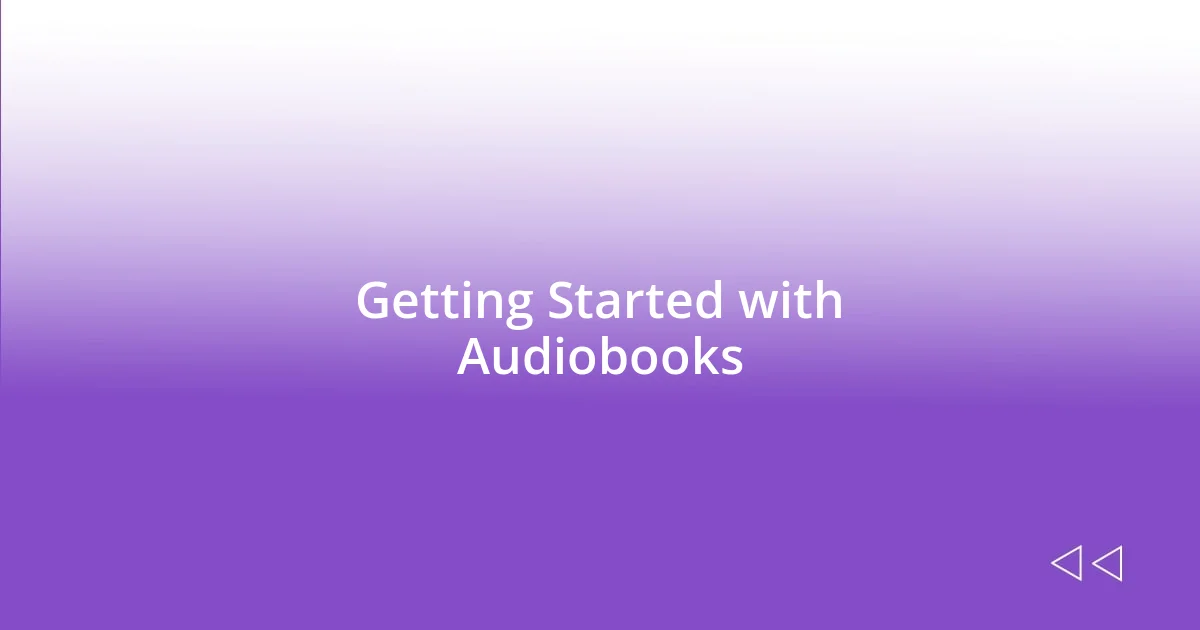
Getting Started with Audiobooks
Getting started with audiobooks is all about finding the right match between the story and the narrator. I vividly recall my first foray into this world; I was on a long road trip, and a gripping thriller filled the car with suspense, making the miles fly by. It was a revelation, seeing how an engaging voice can turn mundane travel into an immersive journey.
To help you dive into audiobooks, consider these steps:
– Choose Your Genre: What do you love? Mystery, romance, or maybe fantasy? Find a genre that excites you.
– Research Narrators: Look for narrators whose voices you enjoy. A familiar voice can make a big difference.
– Start with Shorter Works: Try a novella or a short story to ease into the audiobook experience.
– Use Audiobook Platforms: Explore services like Audible or Libby, where you can browse titles and listen to samples.
– Listen Actively: Engage with the story. Whether at home or on the go, give it your full attention to fully appreciate the experience.
I remember how I got hooked on audiobooks by listening to a short story while doing housework. It made the chore feel less like a task and more like a personal indulgence. I believe this blend of story and convenience is what makes audiobooks such a beloved medium for many.
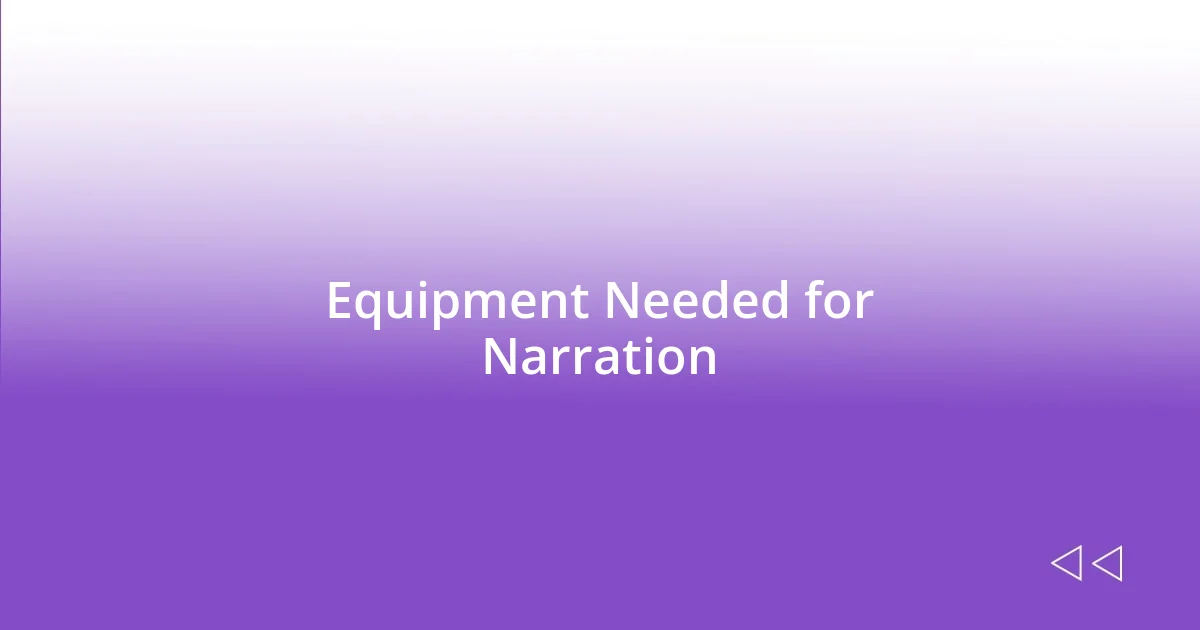
Equipment Needed for Narration
When it comes to audiobook narration, having the right equipment is crucial for achieving high-quality sound. I learned this firsthand; during my initial recordings, I struggled with a basic microphone and ended up with subpar audio. Investing in a quality microphone, such as a condenser mic, truly elevated my narration. The difference was like night and day!
Apart from a great microphone, headphones play a significant role as well. Closed-back headphones help isolate sound, allowing you to hear every nuance in your recording. I can’t tell you how many times I caught stray noises or mispronunciations just by using a good pair of headphones. It turns narration sessions into a more immersive experience where you feel connected to your voice and the story.
Finally, I recommend having audio editing software in your toolkit. Programs like Audacity or Adobe Audition enable you to polish your recordings, fixing errors and enhancing sound quality. I remember the first time I edited one of my recordings; it felt empowering to transform raw audio into something professional. These tools combined can turn your beloved narration project into a masterpiece.
| Equipment | Description |
|---|---|
| Microphone | A high-quality condenser microphone captures your voice clearly. |
| Headphones | Closed-back headphones isolate sound for a focused listening experience. |
| Audio Editing Software | Allows for polishing of recorded audio, enhancing overall quality. |
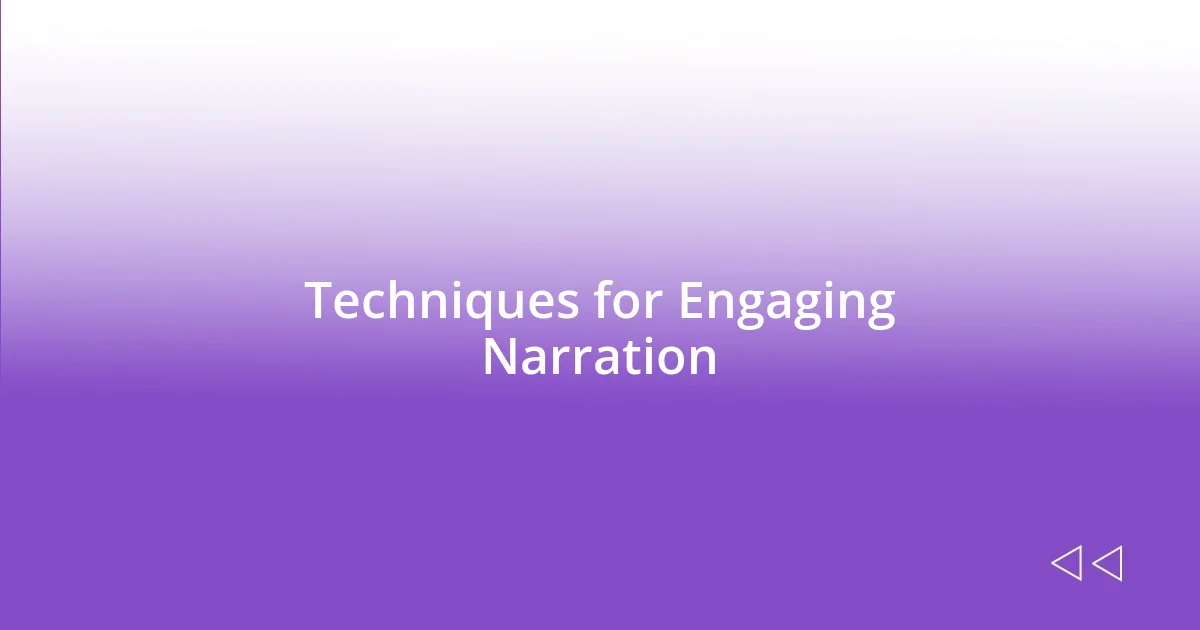
Techniques for Engaging Narration
To create engaging narration, one vital technique is to vary your tone and pace throughout the story. I often find that adjusting my voice to mirror the emotions of the characters brings the scene to life. For instance, when narrating a tense moment, I slow my pace and deepen my tone, allowing listeners to feel the weight of the suspense. Have you noticed how the right vocal inflections can captivate your attention? It’s almost as if the story wraps around you, pulling you in deeper.
Another technique I cherish is the use of character voices. When I first embraced this idea, it felt daunting, yet my early attempts led to some memorable moments. By giving each character a distinct voice—maybe a light drawl for a laid-back character and a sharp, quick tone for the antagonist—I noticed how much more immersive the storytelling became. It’s fascinating how even slight vocal changes can transform a narrative, turning it from a simple reading into a vibrant performance that resonates with the listener.
Lastly, I can’t stress enough the importance of practicing mindfulness and presence during narration sessions. I once found myself distracted by thoughts about my day while recording, and it came through in my voice—flat and lacking energy. Now, I center myself before each session, taking a few deep breaths to clear my mind. This not only enhances my focus but allows me to connect authentically with the material. Have you ever felt the difference when you’re truly present with a story? It’s that connection that brings the words to life, making each listening experience unforgettable.
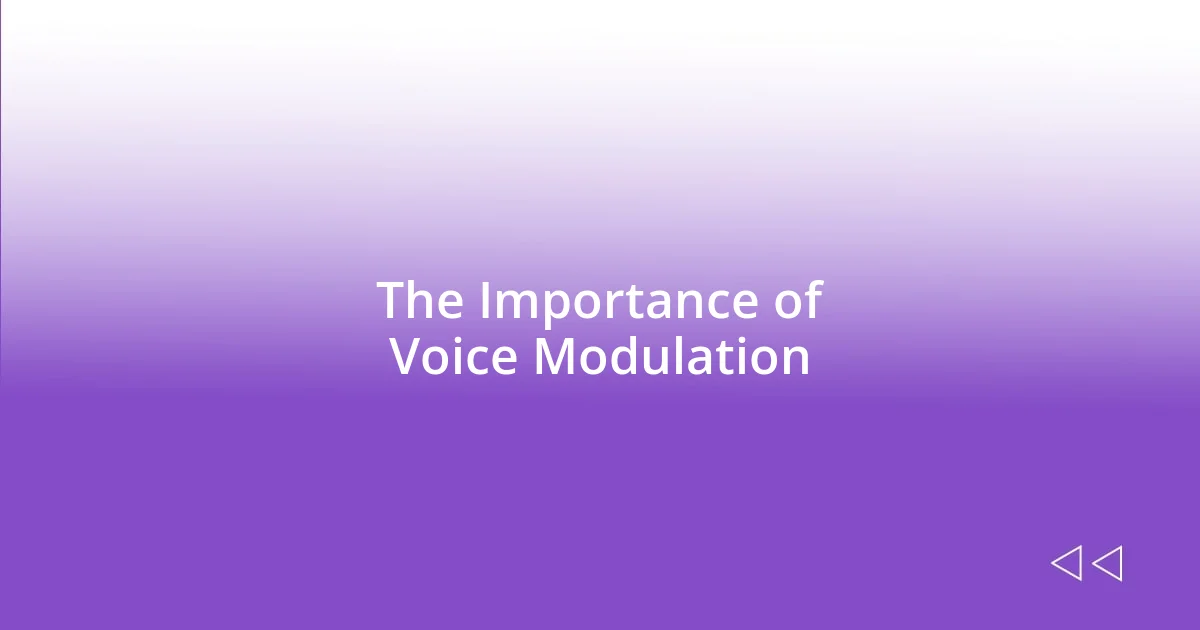
The Importance of Voice Modulation
Voice modulation is a game-changer in audiobook narration. I can recall a time when I recorded a scene without paying much attention to my vocal tones. When I listened back, I felt utterly detached from the emotionally charged moments I was trying to convey. It was evident to me that varied pitch and pace could lead listeners on an emotional journey. Have you ever realized how an actor’s inflection can make you laugh or cry? That’s the magic of voice modulation!
The ability to switch your voice for different characters also hinges on this skill. I remember a particularly challenging character—a wise old sage. Instead of just using a deep tone, I incorporated a softer, trembling quality to evoke age and wisdom. The instant feedback from my listeners confirmed that those subtle changes pulled them into the character’s world. Don’t you think that such attention to detail can elevate a good narration to something magnificent?
Moreover, I’ve learned that modulation is not just about the characters; it’s about aesthetics in storytelling. When I deliberately play with the rhythm of my voice—speeding up during action-packed scenes and slowing down during reflective moments—I notice how it enhances the audience’s engagement. It’s fascinating to see how a simple change in tone can make the words pop or lull the listener into deep contemplation. Can you imagine how a captivating storyteller captures the hearts of their audience? That’s the impact of mastering voice modulation!
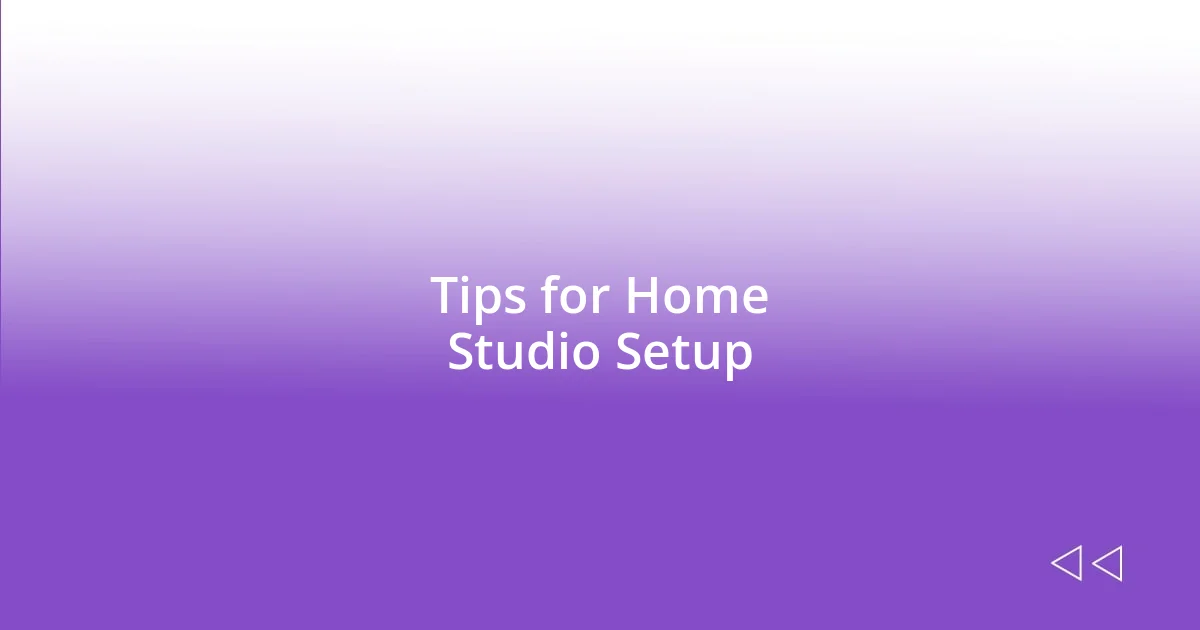
Tips for Home Studio Setup
Setting up a home studio for audiobook narration can truly enhance your recording quality. I remember my early attempts when I just used a quiet room with minimal thought to acoustics. It was only after some time that I invested in sound-absorbing foam panels and discovered how significantly they improved my audio clarity. Have you experienced that “echo” effect when recording? It’s a real game changer when you eliminate it.
Lighting is another detail that often goes overlooked. I initially thought it was just about sound, but when you’re in your recording space for long hours, good lighting helps maintain your mood and energy. I use soft, adjustable LED lights that keep my space bright yet easy on the eyes. Have you ever felt how a well-lit room can impact your creativity? It’s amazing how a simple adjustment can foster a better atmosphere for narration.
Finally, don’t underestimate the importance of a comfortable chair. I made the mistake of using a stiff office chair during lengthy sessions, and let me tell you, discomfort can lead to a distracted and strained performance. Now, I opt for an ergonomic chair that not only supports my back but also allows me to relax and focus on my delivery. Have you noticed how physical comfort can influence your vocal performance? It’s such a relief to know that when you’re at ease, you can deliver your best narration!
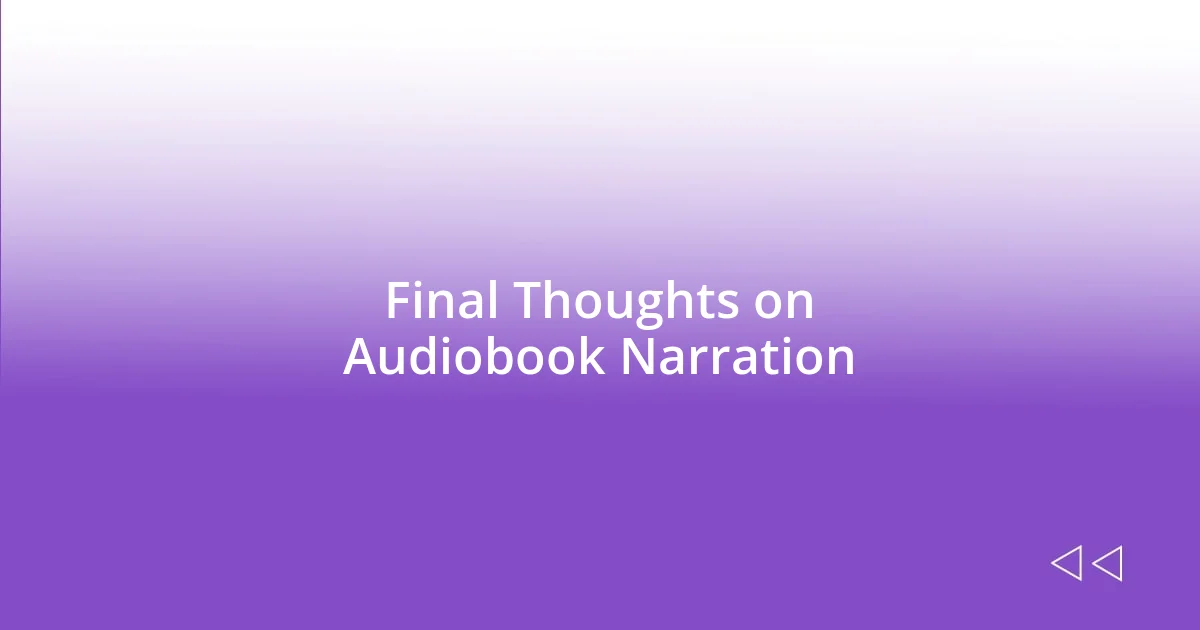
Final Thoughts on Audiobook Narration
Engaging with audiobook narration has truly transformed my approach to storytelling. I often think about a specific project where I immersed myself in the character’s emotions, feeling their struggles as if they were my own. This deep connection made my narration more authentic, demonstrating that it’s not just about reading words; it’s about sharing a heartfelt experience. Have you ever felt that surge of empathy while reading a powerful story? That’s the key.
I’ve also realized that feedback is a gift in this journey. Early on, I hesitated to share my work, worrying that listeners might not respond the way I hoped. But when I finally let my guard down and opened up to comments, I found insights that have shaped my craft significantly. Ongoing dialogue with my audience isn’t just reassuring; it enhances my growth as a narrator. Can you remember a time when constructive criticism shifted your perspective? It’s those moments that make all the difference.
As I reflect on my audiobook narration experiences, I can’t overlook the thrill of capturing moments in time—like reading a passage that leaves listeners breathless or making them laugh unexpectedly. To me, these moments represent the essence of storytelling. Every word, every inflection, and every pause carries the weight of connection. I often wonder: isn’t that what we all seek in a story? The opportunity to be a part of something greater, a shared journey of emotions and imagination.












